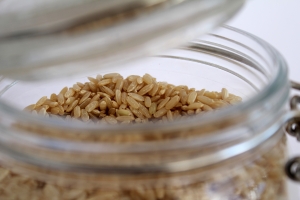 Are you hungry for whole grains? Check out myeasy guide to whole grains from The Beauty Bean.
Are you hungry for whole grains? Check out myeasy guide to whole grains from The Beauty Bean.
Whole Grains: A Cooking & Eating Guide
By Marissa Vicario
You know whole grains are an essential part of a healthy diet, but these days it seems like almost every food item on the shelf boasts them as a main ingredient. So what exactly are they and how can you make sense of them? Here’s the skinny on this vitamin-packed energizing ingredient.
Grains are an excellent source of nutrition, packed full of essential enzymes, iron, fiber and vitamins E and B-complex. Our bodies absorb them slowly, making them an ideal source of high-quality energy that will keep you full and satisfied until your next meal.
Whole grains have long been a central element of the human diet. Once technology allowed humans to cultivate grain products, they settled into farming communities and said goodbye to the days of hunting and gathering. The nutrition in whole grains allowed people to grow lean, strong bodies and they were seldom out of shape. From rice to sorghum, staple grains varied from country to country because of climate and lifestyle.
Today, there are a plethora of grains to choose from—widely available bagged or in bulk at your local supermarket or health food store. One of the most commonly-eaten grains, brown rice, has all of its bran layers intact, which means it still contains all of its naturally present nutrients and the highest amount of B vitamins among grains. Its high nutritional value makes brown rice a great choice for generating energy, promoting digestion and quenching thirst. Grains, though, come in more forms than just rice. Rather, there are a handful of alternatives that can add variety and texture to your diet:
Kasha, or buckwheat, is a traditional food of Russia. Roasted to a deep amber color, buckwheat has a nutty flavor and is the most filling grain. It stabilizes blood sugar, benefits circulation, strengthens the kidneys and is the highest in calcium.
Millet is a small, round grain popular all over the world. Its high protein, fiber, magnesium and potassium content make it an ideal treatment for morning sickness and indigestion. It also supports the kidneys and stomach and is actually recommended in cool, rainy weather for its warming properties.
Quinoa, the most nutritious and fastest-cooking grain, contains all eight amino acids making it a complete protein with protein levels equal to milk. It is also high in B vitamins, iron, zinc and vitamin E making it an ideal food both for endurance and for strengthening the kidneys, heart and lungs. Those with sensitive stomachs will also be happy to know that it is very easy to digest.
Other great examples are oats, amaranth, barley, bulgur, polenta, kamut, spelt and wheat berries. So, try them all! The grain that’s right for you depends on your palate and nutritional needs so experiment with the varieties and flavors, add spices, nuts and seeds, and unlock the true benefit of grains.
Remember:
– Grains keep best (up to nine months) stored in air-tight glass containers in a dark cupboard.
– Soak or rinse your grains before cooking to make them easier to digest and the nutrients more accessible.
– Dry roast them before cooking (in a pan over a low flame) both to give your grains of choice a richer flavor and to make them more alkaline.



Leave a Reply